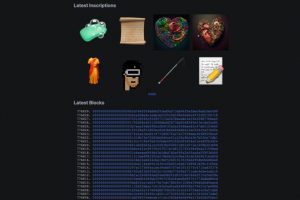Bringing NFTs to Bitcoin: The Innovation of Casey Rodarmor’s Ordinals Protocol

In a recent interview, Casey Rodarmor, the creator of the Ordinals project, shared his thoughts about one of the hottest projects in the crypto space.
According to a report by George Kaloudis, a senior research analyst and columnist for CoinDesk who recently interviewed Rodarmor, the Bitcoin developer began working on Ordinals in 2022, drawing inspiration directly from Bitcoin’s pseudonymous founder, Satoshi Nakamoto. The Ordinals protocol is apparently based on Satoshi’s original inclusion of references to something called “atoms” in the Bitcoin codebase. By sequentially numbering satoshis, the smallest unit of Bitcoin, users can inscribe data onto those satoshis to create digital artifacts.
Unlike most other types of NFTs, which tend to store the actual image or text file somewhere else and then put a link to that data on the blockchain, inscriptions on Ordinal NFTs are always immutable, which Rodarmor views as an upgrade to the immutability of NFTs.
While some in the Bitcoin community have criticized Ordinals as a threat to the sovereignty of Bitcoin users and holders, Rodarmor believes that engaging in one-on-one conversations with critics can lead to finding common ground.
Kaloudis is unsure whether Ordinal NFTs will solve Bitcoin’s security budget problem, so the CoinDesk analyst and writer asked Rodarmor what he thought.
Rodarmor’s response was, “YOLO. Let’s find out.”
The Ordinals creator said in a blog post published on 20 January 2023 that the Ordinals protocol supports putting “inscriptions” on the Bitcoin blockchain, and then went on to explain how inscriptions are different from NFTs:
“Inscriptions are digital artifacts native to the Bitcoin blockchain. They are created by inscribing sats with content using ord, and can be viewed with the ordinals explorer. They do not require a separate token, a side chain, or changing Bitcoin. Inscriptions are created by including content, like an image, text, SVG, or HTML, in an inscription transaction. The content is included in the transaction witness, which normally contains signatures and other data proving that a transaction is authorized. Along with the content, the inscription transaction contains a content type, also known as a MIME type, identifying the type of content to be inscribed…
“Inscriptions are digital artifacts, and digital artifacts are NFTs, but not all NFTs are digital artifacts. Digital artifacts are NFTs held to a higher standard, closer to their ideal. For an NFT to be a digital artifact, it must be decentralized, immutable, on-chain, and unrestricted. The vast majority of NFTs are not digital artifacts. Their content is stored off-chain and can be lost, they are on centralized chains, and they have back-door admin keys. What’s worse, because they are smart contracts, they must be audited on a case-by-case basis to determine their properties. Inscriptions are unplagued by such flaws. Inscriptions are immutable and on-chain, on the oldest, most decentralized, most secure blockchain in the world. They are not smart contracts, and do not need to be examined individually to determine their properties. They are true digital artifacts.“
On 7 February 2023, Binance Research said that “in recent weeks, the Ordinals protocol has gained widespread popularity, with users experimenting by embedding JPEGs, videos, and even PDFs onto the blockchain. It also mentioned that while some Bitcoin community members have raised concerns about the Ordinals protocol potentially driving up transaction fees by consuming block space on the Bitcoin network, there is an ongoing debate about whether this is a positive or negative development for the blockchain.
On the same day, independent developer and consultant Udi Wertheimer listed some of the benefits of Bitcoin NFTs:
Source: Read Full Article
